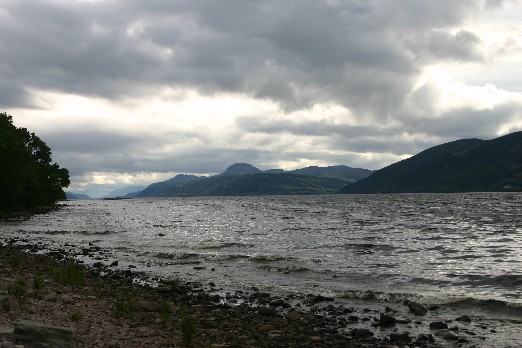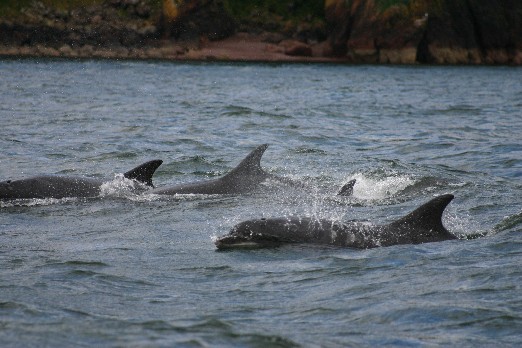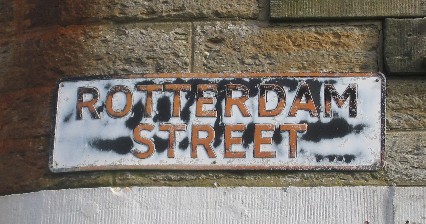|
Wednesday 29 August 2007
This morning we drive to the Glenlivet
Estate. This is a Crown Estate of about 23.000 hectares (56.000 acres), open
to the public and comprising a couple of villages and hamlets. There are several way marked walking and cycling routes to be made. We choose
the Glenbrown and Kylnadrochit walk nr 8 which is 6,75km long. The route is a
bit hilly and offers splendid views of the estate and heather covered hills. We
see lots of sheep and rabbits, but no big wildlife. There are some very muddy
patches, but it is never impassable. After a good 2.5 hours we are back at the
car near Tomintoul, just when it starts raining. We drive to
Tomintoul (pronounced as "tom-in-towel") and have lunch in a restaurant
called Clock House on the central square. Tomintoul is situated on 400m
above sea level and came into being after the 1745 clearances sparked by
panicking landowners after a couple of riots by crofters. People were driven of
their land and herded into planned villages like Tomintoul, were they could be
watched more easily. After lunch we drive back to Craigelachie via Dufftown. Dufftown
has the biggest concentration of distilleries, among which Glenfiddich's,
the first company that started producing single malt whisky in the 1970s. It
turned out to be a runaway success and many distilleries followed suit by
shifting their focus from Blended to Single Malt Whisky. Dufftown claims to be "Malt
Whisky Capital of the World". In Dufftown more tax revenue is generated per
head of its population than anywhere else in Britain. There are 9
distilleries in all in and around the village. We drive on and stop at the Speyside
Cooperage, on the edge of Craigellachie, for a tour. It is a self guided tour
through an exhibition, showing the history of making casks for whisky. We see a
film before we move on to a visitors gallery overlooking the the hall where the
coopers make and repair the whisky casks. A guide explains us what we are
seeing. The coopers are being paid per casks finished and make about 45 hours a
week. They earn well, the guide assures us. We really do not have to pity them.
They make about 20 regular casks a day. Whisky casks are made of oak, imported
from the US and Canada. After use the casks are sent to the cooperage for
repairs. Most casks are reused 3 to 5 times with whisky maturing in them for 10
to 18 years.
There are several way marked walking and cycling routes to be made. We choose
the Glenbrown and Kylnadrochit walk nr 8 which is 6,75km long. The route is a
bit hilly and offers splendid views of the estate and heather covered hills. We
see lots of sheep and rabbits, but no big wildlife. There are some very muddy
patches, but it is never impassable. After a good 2.5 hours we are back at the
car near Tomintoul, just when it starts raining. We drive to
Tomintoul (pronounced as "tom-in-towel") and have lunch in a restaurant
called Clock House on the central square. Tomintoul is situated on 400m
above sea level and came into being after the 1745 clearances sparked by
panicking landowners after a couple of riots by crofters. People were driven of
their land and herded into planned villages like Tomintoul, were they could be
watched more easily. After lunch we drive back to Craigelachie via Dufftown. Dufftown
has the biggest concentration of distilleries, among which Glenfiddich's,
the first company that started producing single malt whisky in the 1970s. It
turned out to be a runaway success and many distilleries followed suit by
shifting their focus from Blended to Single Malt Whisky. Dufftown claims to be "Malt
Whisky Capital of the World". In Dufftown more tax revenue is generated per
head of its population than anywhere else in Britain. There are 9
distilleries in all in and around the village. We drive on and stop at the Speyside
Cooperage, on the edge of Craigellachie, for a tour. It is a self guided tour
through an exhibition, showing the history of making casks for whisky. We see a
film before we move on to a visitors gallery overlooking the the hall where the
coopers make and repair the whisky casks. A guide explains us what we are
seeing. The coopers are being paid per casks finished and make about 45 hours a
week. They earn well, the guide assures us. We really do not have to pity them.
They make about 20 regular casks a day. Whisky casks are made of oak, imported
from the US and Canada. After use the casks are sent to the cooperage for
repairs. Most casks are reused 3 to 5 times with whisky maturing in them for 10
to 18 years.
After a short break in our B&B we go yet again to the
Highlander Inn for a pint and a pub meal. The food is good and the service very
friendly. After dinner I do a tasting of a flight of 6 Speyside whiskies.
Speyside being the area we are now in. Speyside has more distilleries than any
other Whisky region with over 40 of them. I get a tasting form for making notes
on the colour, nose and taste. The glasses are neatly lined up on a special
plank and are covered with glass lids to preserve the aroma. For the occasion
the bottles are placed on our table as well. It was a true pleasure to get the
chance to learn more about these whiskies. Back at the B&B we watch the
football match between Celtic Glasgow and Spartak Moscow. Celtic wins after
penalties and gets to join the Champions League. The next day this happy
sportive event is all over the front pages of the Scottish press.
Weather: sunny start, later overcast and rain. Dry
evening. 16°C/61°F
Thursday 30 August 2007
Craigellachie - Inverness 97km /
61mi
After breakfast we are on our way to Inverness.
When we get there we go straight Kwik Fit to get the tire repaired. Hertz has
told us that we should have it fixed there. It turns out that the tire is beyond
repair and will have to be replaced, costing £98. Our B&B is about 15
minutes outside Inverness, in Dores on the shore of Loch
Ness. John and Glen own the nice and tidy B&B, called Pottery
House, where we have a spacious room, with modern furniture. From our window
we can see Loch Ness. No monster to be seen!
Back in Inverness we have lunch at Café One. Inverness is
not a very attractive town. There are very few historic buildings and the new
ones show a blatant lack of  architectural
finesse. The town calls itself the capital or gateway to the Highlands.
Which is probably well deserved, as there are no other towns or cities in the
highlands. It will turn out to be the only place in the Highlands with any half
way decent shops, cinemas, theatre and anything resembling a night life, that we
will come across in the highlands. We head for the Kilt making centre, based
above a outfitter for typical Scottish clothing. There is a small exhibition
with a view on the workshop where the Kilts are put together by a group of five
seamstresses. The exhibition tells the story of the Kilts and Tartan, the cloth
from which the kilts are made. It is a bit of a romanticised version of the
history. The truth of the matter is the original kilts were made from an almost
watertight cloth, called Helande, woven from wool of indigenous sheep. The
colours were clear, but soft and offered some sort of camouflage in the hills.
It was worn like a toga, wrapped around the waist and knocked back over the
shoulder. Tartan did not become popular until Sir Walter Scott, the writer/solicitor
made it into the national symbol demonstrating Scottish unique character. He
invited King George IV to Edinburgh in 1822 and dressed the monarch in a kilt
and flesh coloured tights. When Queen Victoria discovered Scotland as a holiday
destination Tartan and Kilts definitely became synonymous with all things
Scottish. The screamingly colourful designs of the tartans and the cultivated
and registered patterns for each individual clan are in reality a 19th century
invention and not a centuries old tradition. But that does not deter the
Scottish tourist industry. Tartan sells, especially to descendants of emigrated
Scots. These days souvenir shops sport lists titled "What's my tartan?".
You have to be related in one way or another to a clan to be able to wear a
certain tartan. Great feats of genealogical gymnastics were performed in the
concoction of these lists. A "real" kilt consists of about 4 metres of
cloth and costs around £300. The rest of the mandatory apparel like the jacket,
bag, socks, shoes and knife will double that for a complete outfit. Most Scots
wear this costume to weddings or other formal occasions. architectural
finesse. The town calls itself the capital or gateway to the Highlands.
Which is probably well deserved, as there are no other towns or cities in the
highlands. It will turn out to be the only place in the Highlands with any half
way decent shops, cinemas, theatre and anything resembling a night life, that we
will come across in the highlands. We head for the Kilt making centre, based
above a outfitter for typical Scottish clothing. There is a small exhibition
with a view on the workshop where the Kilts are put together by a group of five
seamstresses. The exhibition tells the story of the Kilts and Tartan, the cloth
from which the kilts are made. It is a bit of a romanticised version of the
history. The truth of the matter is the original kilts were made from an almost
watertight cloth, called Helande, woven from wool of indigenous sheep. The
colours were clear, but soft and offered some sort of camouflage in the hills.
It was worn like a toga, wrapped around the waist and knocked back over the
shoulder. Tartan did not become popular until Sir Walter Scott, the writer/solicitor
made it into the national symbol demonstrating Scottish unique character. He
invited King George IV to Edinburgh in 1822 and dressed the monarch in a kilt
and flesh coloured tights. When Queen Victoria discovered Scotland as a holiday
destination Tartan and Kilts definitely became synonymous with all things
Scottish. The screamingly colourful designs of the tartans and the cultivated
and registered patterns for each individual clan are in reality a 19th century
invention and not a centuries old tradition. But that does not deter the
Scottish tourist industry. Tartan sells, especially to descendants of emigrated
Scots. These days souvenir shops sport lists titled "What's my tartan?".
You have to be related in one way or another to a clan to be able to wear a
certain tartan. Great feats of genealogical gymnastics were performed in the
concoction of these lists. A "real" kilt consists of about 4 metres of
cloth and costs around £300. The rest of the mandatory apparel like the jacket,
bag, socks, shoes and knife will double that for a complete outfit. Most Scots
wear this costume to weddings or other formal occasions.
We have a wee drink in a pub before we go to our room at
the B&B in Dores. We have a break and take a short walk along the shore of
Loch Ness. We then get back into town for pre-dinner drinks at Pivo, a trendy
lounge bar. It is part of chain, specialised in Czech beers, Pivo meaning beer
in the Czech language. We have dinner at the Mustard
Seed. A large restaurant, in a nicely converted church. The place is packed
to capacity and the food is okay, but will not win any prizes. We have a coffee
in a coffee place before we start looking for a quiet bar. The Glen Mhor hotel
has a fine lounge bar, which is virtually deserted. Back to Dores.
Weather: cloudy. A drizzle at times. 14°C/57°F
Friday 31 August 2007
Inverness - Cromarty - Thurso
189km / 118mi
After breakfast we drive to the Black Isle, a peninsula
North East of Inverness. In the village of Cromarty
at the very Eastern tip  of the Cromarty Firth, about 45 minutes outside Inverness, we will go on a
Dolphin watching tour with Ecoventures.
Booking is essential in order to avoid disappointments. The company is led by a
group of women. We set out to sea in a rubber boat big enough to seat 12
passengers. In the Cromarty
Firth itself we do not see anything, but once out in the North Sea (here
parochially known as the Moray Firth) we see groups of dolphins dive and
jump all over the place. We see them go down and reemerge all around us and it
seems that they are following us out of sheer curiosity. They are bottlenose
dolphins, who can get as long as 3 metres. Later we follow the coast line and
get to see lots of water birds like
of the Cromarty Firth, about 45 minutes outside Inverness, we will go on a
Dolphin watching tour with Ecoventures.
Booking is essential in order to avoid disappointments. The company is led by a
group of women. We set out to sea in a rubber boat big enough to seat 12
passengers. In the Cromarty
Firth itself we do not see anything, but once out in the North Sea (here
parochially known as the Moray Firth) we see groups of dolphins dive and
jump all over the place. We see them go down and reemerge all around us and it
seems that they are following us out of sheer curiosity. They are bottlenose
dolphins, who can get as long as 3 metres. Later we follow the coast line and
get to see lots of water birds like  Cormorants and Kittiwakes. After two hours we speed back to the quay in
Cromarty. We drive to Rosemakie, where we have lunch in the Plough Inn. After
that we start on the long drive to Thurso. The route takes us via the A9 along
the North Sea coast and almost three hours later we arrive in Thurso. Tigh
na Abhainn is a simple Guest house, full of nicknackery. Our room is
big and clean, but the shower and toilet are out on the corridor. We go into
town, and find nothing memorable. The most important shopping street, however,
is called Rotterdam Street (!), which does speak in Thurso's
favour. We drink a pint in Joe's Top Bar and have dinner in Le
Bistro, the only restaurant that actually looks like one. Later in the evening
we stroll along the beach and go for a night cap to The Grove Lounge, and
enjoy watching the merry local crowd.
Cormorants and Kittiwakes. After two hours we speed back to the quay in
Cromarty. We drive to Rosemakie, where we have lunch in the Plough Inn. After
that we start on the long drive to Thurso. The route takes us via the A9 along
the North Sea coast and almost three hours later we arrive in Thurso. Tigh
na Abhainn is a simple Guest house, full of nicknackery. Our room is
big and clean, but the shower and toilet are out on the corridor. We go into
town, and find nothing memorable. The most important shopping street, however,
is called Rotterdam Street (!), which does speak in Thurso's
favour. We drink a pint in Joe's Top Bar and have dinner in Le
Bistro, the only restaurant that actually looks like one. Later in the evening
we stroll along the beach and go for a night cap to The Grove Lounge, and
enjoy watching the merry local crowd.
|
